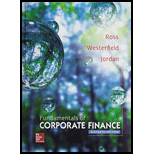
Concept explainers
Arithmetic and Geometric Returns [LO1] A stock has had the following year-end prices and dividends:
| Year | Price | Dividend |
| 1 | $51.50 | - |
| 2 | 59.32 | $.65 |
| 3 | 64.13 | .70 |
| 4 | 57.86 | .77 |
| 5 | 65.19 | .86 |
| 6 | 74.86 | .95 |
What are the arithmetic and geometric returns for the stock?
To determine: The arithmetic and geometric average return.
Introduction:
Total return refers to the total income from an investment. The total income includes the periodic incomes and the increase or decrease in the value of an asset.
Arithmetic average return refers to the returns that an investment earns in an average year over different periods.
Geometric average return refers to the return after compounding the average returns for multiple years.
Answer to Problem 16QP
The arithmetic average return is 9.52 percent. The geometric average return is 9.09 percent.
Explanation of Solution
Given information:
The price of the stock at the end of first year is $51.50. The price of the stock at the end of the second year is $59.32, and the dividend paid is $0.65. The price of the stock at the end of the third year is $64.13, and the dividend paid is $0.70. The price of the stock at the end of the fourth year is $57.86, and the dividend paid is $0.77.
The price of the stock at the end of the fifth year is $65.19, and the dividend paid is $0.86. The price of the stock at the end of the sixth year is $74.86, and the dividend paid is $0.95.
The formula to calculate the total percentage returns:
The formula to calculate the arithmetic average return:
Where,
“Xi” refers to each of the observations from X1 to XN (as “i” goes from 1 to “N”)
“N” refers to the number of observations
The formula to calculate the geometric average return:
Where,
“R” is the annual returns for the investment
“T” is the years of returns
Compute the percentage return for the second year:
The closing price of the stock is $59.32, and the beginning price is $51.50. The dividend received in the second year is $0.65.
Hence, the percentage return for Year 2 is 16.45 percent.
Compute the percentage return for the third year:
The closing price of the stock is $64.13, and the beginning price is $59.32. The dividend received in the second year is $0.70.
Hence, the percentage return for Year 3 is 9.29 percent.
Compute the percentage return for the fourth year:
The closing price of the stock is $57.86, and the beginning price is $64.13. The dividend received in the second year is $0.77.
Hence, the percentage return for Year 4 is (8.57 percent).
Compute the percentage return for the fifth year:
The closing price of the stock is $65.19, and the beginning price is $57.86. The dividend received in the second year is $0.86.
Hence, the percentage return for Year 5 is 14.15 percent.
Compute the percentage return for the sixth year:
The closing price of the stock is $74.86, and the beginning price is $65.19. The dividend received in the second year is $0.95.
Hence, the percentage return for Year 6 is 16.29 percent.
Compute the arithmetic average return:
The return for the second year is 16.45 percent, the return for the third year is 9.29 percent, the return for the fourth year is (8.57 percent), the return for the fifth year is 14.15 percent, and the return for the sixth year is 16.29 percent.
Hence, the arithmetic average return is 0.0952 or 9.52 percent.
Compute the geometric average return:
Hence, the geometric average return is 9.09 percent.
Want to see more full solutions like this?
Chapter 12 Solutions
Fundamentals of Corporate Finance with Connect Access Card
- How is return on investment (ROI) used in performance evaluation? i need help in thisarrow_forwardHow is return on investment (ROI) used in performance evaluation in finance? i need answerarrow_forwardBase on Amazon I need help Identify 2 key performance indicators. Relate the stock price to price-to-earnings ratio. Explain the market capitalization and what it means to the investor. Identify trends in stock price, dividend payout, and total stockholders’ equity. Relate recent events or market conditions to the trends you identified. Determining based on your analysis, whether you think the organization is going to meet its financial goals, describe the outlook for growth and sustainability, and explain why you do or do not recommend this stock for purchase and how your recommendation compares to that of other analysts. For example, if your suggestion is buy, you need to explain why other analysts say sell.arrow_forward
 Essentials Of InvestmentsFinanceISBN:9781260013924Author:Bodie, Zvi, Kane, Alex, MARCUS, Alan J.Publisher:Mcgraw-hill Education,
Essentials Of InvestmentsFinanceISBN:9781260013924Author:Bodie, Zvi, Kane, Alex, MARCUS, Alan J.Publisher:Mcgraw-hill Education,

 Foundations Of FinanceFinanceISBN:9780134897264Author:KEOWN, Arthur J., Martin, John D., PETTY, J. WilliamPublisher:Pearson,
Foundations Of FinanceFinanceISBN:9780134897264Author:KEOWN, Arthur J., Martin, John D., PETTY, J. WilliamPublisher:Pearson, Fundamentals of Financial Management (MindTap Cou...FinanceISBN:9781337395250Author:Eugene F. Brigham, Joel F. HoustonPublisher:Cengage Learning
Fundamentals of Financial Management (MindTap Cou...FinanceISBN:9781337395250Author:Eugene F. Brigham, Joel F. HoustonPublisher:Cengage Learning Corporate Finance (The Mcgraw-hill/Irwin Series i...FinanceISBN:9780077861759Author:Stephen A. Ross Franco Modigliani Professor of Financial Economics Professor, Randolph W Westerfield Robert R. Dockson Deans Chair in Bus. Admin., Jeffrey Jaffe, Bradford D Jordan ProfessorPublisher:McGraw-Hill Education
Corporate Finance (The Mcgraw-hill/Irwin Series i...FinanceISBN:9780077861759Author:Stephen A. Ross Franco Modigliani Professor of Financial Economics Professor, Randolph W Westerfield Robert R. Dockson Deans Chair in Bus. Admin., Jeffrey Jaffe, Bradford D Jordan ProfessorPublisher:McGraw-Hill Education





